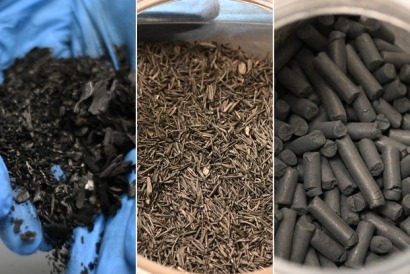
The researchers will work to engineer solutions to replace the use of a high carbon material made from coal — called coke — with biomass, which is derived from organic components like plants and wood, in steel and iron manufacturing.
They also plan to develop a microcredential program geared toward steelworkers from underrepresented groups who need certification for advancement within the steel industry. The program will focus on topics such as sustainable manufacturing, bio-based fuel and eco-friendly engineering.
Penn State News spoke with Mazyck and Whisler about the research they will conduct with the grant.
Q: What is biomass, and how can it be used as an energy substitute for coal?
Mazyck: Biomass, otherwise known as biochar, is a clean renewable organic material from plants, derived from materials like saw dust and rice husks, that are rich in carbon. Similar to coal, biomass has high energy content that is used across the globe for energy generation.
Whisler: At the moment, our focus is on biochar derived from wood because it has the ideal properties necessary for the steel and iron industries. But since biochar can come from a variety of sources, rice husk-based biochar is another example we might encounter and ultimately find a use for either by itself or blended with other materials.
Q: How will substituting biomass for coal result in lower greenhouse gas emissions during the manufacturing process?
Mazyck: Biomass is considered a carbon-neutral energy source because it relies on photosynthesis and consumes carbon dioxide while growing.
Whisler: A further reduction in emissions comes from our biomass source: we plan to utilize the remnants from the lumber and agriculture industries as the primary inputs. When accounting for this upcycling in the full steel lifecycle, we can realize additional carbon reductions.
Q: How will your proposed microcredential program assist steelworkers from underrepresented groups in advancing in the steel industry?
Mazyck: Microcredentials offer short, learned experiences that can fill gaps in the educational journey. For example, microcredentials in communication skills, business and leadership are often skills learned while working. Microcredentials can augment work experience from world-class faculty who have specific expertise in these areas.
Whisler: By meeting their needs and on their schedules, we hope to provide an equitable foundation for steelworkers to get the focused, industry-specific training that balances current practices with emerging trends in carbon reductions. And as they and the industry advance, we look forward to being their lifelong ally with stackable certifications.
Q: How will this project make an impact?
Mazyck: We appreciate the Department of Energy's support in advancing our understanding of how we can reduce carbon emissions during steel manufacturing. The project has the potential to be commercialized, to create new jobs in Pennsylvania and to benefit steel manufacturing throughout the commonwealth and the US
Q: How is Penn State suited to take on this project?
Whisler: Penn State brings amazing synergy with exceptional faculty, talented researchers and dedicated students who are all tackling some of the biggest challenges facing our world. And reflecting on our state's storied history in steel and the many who industrialized this nation with it, I am excited to see how we at SEDI will make an impact.
PHOTO: Researchers propose using biomass made from wood, seen at left, or rice husks, seen in middle, to replace the use of coke in the steel and manufacturing industry. At right is an example of the finished wood-based biochar pellets that would be used in manufacturing. Credit: Provided by Daniel Whisler

